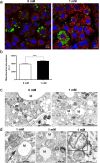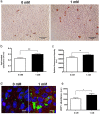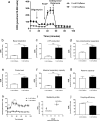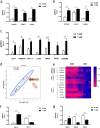Caffeine exposure induces browning features in adipose tissue in vitro and in vivo
- PMID: 31235722
- PMCID: PMC6591281
- DOI: 10.1038/s41598-019-45540-1
Caffeine exposure induces browning features in adipose tissue in vitro and in vivo
Abstract
Brown adipose tissue (BAT) is able to rapidly generate heat and metabolise macronutrients, such as glucose and lipids, through activation of mitochondrial uncoupling protein 1 (UCP1). Diet can modulate UCP1 function but the capacity of individual nutrients to promote the abundance and activity of UCP1 is not well established. Caffeine consumption has been associated with loss of body weight and increased energy expenditure, but whether it can activate UCP1 is unknown. This study examined the effect of caffeine on BAT thermogenesis in vitro and in vivo. Stem cell-derived adipocytes exposed to caffeine (1 mM) showed increased UCP1 protein abundance and cell metabolism with enhanced oxygen consumption and proton leak. These functional responses were associated with browning-like structural changes in mitochondrial and lipid droplet content. Caffeine also increased peroxisome proliferator-activated receptor gamma coactivator 1-alpha expression and mitochondrial biogenesis, together with a number of BAT selective and beige gene markers. In vivo, drinking coffee (but not water) stimulated the temperature of the supraclavicular region, which co-locates to the main region of BAT in adult humans, and is indicative of thermogenesis. Taken together, these results demonstrate that caffeine can promote BAT function at thermoneutrality and may have the potential to be used therapeutically in adult humans.
Conflict of interest statement
The authors declare no competing interests.
Figures






Similar articles
-
UCP1 in adipose tissues: two steps to full browning.Biochimie. 2017 Mar;134:127-137. doi: 10.1016/j.biochi.2017.01.007. Epub 2017 Jan 18. Biochimie. 2017. PMID: 28109720
-
Transcriptional regulation of the uncoupling protein-1 gene.Biochimie. 2017 Mar;134:86-92. doi: 10.1016/j.biochi.2016.09.017. Epub 2016 Oct 5. Biochimie. 2017. PMID: 27693079 Review.
-
A dual Ucp1 reporter mouse model for imaging and quantitation of brown and brite fat recruitment.Mol Metab. 2019 Feb;20:14-27. doi: 10.1016/j.molmet.2018.11.009. Epub 2018 Nov 28. Mol Metab. 2019. PMID: 30580967 Free PMC article.
-
Effects of resveratrol and its derivative pterostilbene on brown adipose tissue thermogenic activation and on white adipose tissue browning process.J Physiol Biochem. 2020 May;76(2):269-278. doi: 10.1007/s13105-020-00735-3. Epub 2020 Mar 13. J Physiol Biochem. 2020. PMID: 32170654 Review.
-
Is Exercise a Match for Cold Exposure? Common Molecular Framework for Adipose Tissue Browning.Int J Sports Med. 2020 Jun;41(7):427-442. doi: 10.1055/a-1100-7118. Epub 2020 Apr 6. Int J Sports Med. 2020. PMID: 32252102 Review.
Cited by
-
Association between coffee intake and skeletal muscle mass among U.S. adults: a population-based study.Front Nutr. 2024 Aug 7;11:1390309. doi: 10.3389/fnut.2024.1390309. eCollection 2024. Front Nutr. 2024. PMID: 39171111 Free PMC article.
-
Targeting lipid droplets and lipid droplet-associated proteins: a new perspective on natural compounds against metabolic diseases.Chin Med. 2024 Sep 4;19(1):120. doi: 10.1186/s13020-024-00988-w. Chin Med. 2024. PMID: 39232826 Free PMC article. Review.
-
Effects of Caffeine on Egg Quality and Performance of Laying Hens.Front Vet Sci. 2020 Sep 25;7:545359. doi: 10.3389/fvets.2020.545359. eCollection 2020. Front Vet Sci. 2020. PMID: 33102566 Free PMC article.
-
Bioactive Compounds and Adipocyte Browning Phenomenon.Curr Issues Mol Biol. 2022 Jul 5;44(7):3039-3052. doi: 10.3390/cimb44070210. Curr Issues Mol Biol. 2022. PMID: 35877434 Free PMC article. Review.
-
An update on brown adipose tissue and obesity intervention: Function, regulation and therapeutic implications.Front Endocrinol (Lausanne). 2023 Jan 11;13:1065263. doi: 10.3389/fendo.2022.1065263. eCollection 2022. Front Endocrinol (Lausanne). 2023. PMID: 36714578 Free PMC article. Review.
References
-
- U Din Mueez, Saari Teemu, Raiko Juho, Kudomi Nobu, Maurer Stefanie F., Lahesmaa Minna, Fromme Tobias, Amri Ez-Zoubir, Klingenspor Martin, Solin Olof, Nuutila Pirjo, Virtanen Kirsi A. Postprandial Oxidative Metabolism of Human Brown Fat Indicates Thermogenesis. Cell Metabolism. 2018;28(2):207-216.e3. doi: 10.1016/j.cmet.2018.05.020. - DOI - PubMed
Publication types
MeSH terms
Substances
Grants and funding
LinkOut - more resources
Full Text Sources
Medical
Research Materials

